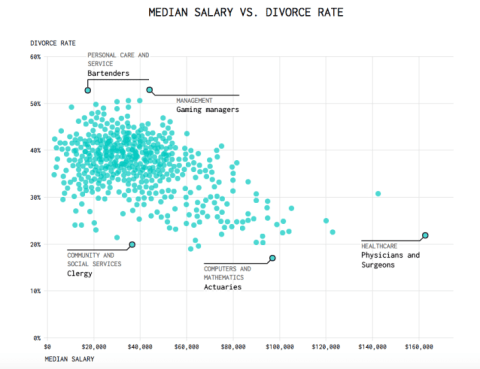How Your Job Can Predict Whether Or Not You’ll Get Divorced

These days, divorce is actually on the wane—2016 marked a nearly 40-year low in U.S. divorces—but whether or not you and your beloved spouse eventually part ways isn’t entirely up to fate. While individual relationships are all unique, statistically, there are demographic and other factors that influence whether or not a couple will divorce, from no-brainers like whether or not you’re willing to share chores equitably to more subtle factors like whether one partner smokes.
Your job matters too, as statistician Nathan Yau found in his analysis of 2015 data from the Census Bureau’s 5-year American Community Survey. As Business Insider and Entrepreneur report, the data shows that there can be vastly different divorce statistics when you’re talking about the marriages of bartenders and those of physical therapists, for instance.

That doesn’t mean that going to work in a physical therapy office somehow better equips you for marriage than tending bar. Higher incomes and education levels, both intimately tied to your job, are also correlated with lower divorce rates. Sure, maybe the fact that flight attendants have to be away from their families for their job plays into their high divorce rates, but perhaps the type of person who wants to be a flight attendant might also be less inclined to settle down compared to people who dream of being an actuary.
Where does your job fall? Here are 10 fields with the lowest divorce rates surveyed:
1. Actuaries: 17 percent
2. Physical scientists: 18.9 percent
3. Medical and life scientists: 19.6 percent
4. Clergy: 19.8 percent
5. Software developers, applications and systems software: 20.3 percent
6. Physical therapists: 20.7 percent
7. Optometrists: 20.8 percent
8. Chemical engineers: 21.1 percent
9. Directors of religious activities and education: 21.3 percent
10. Physicians and surgeons: 21.8 percent
And here are the 10 highest-divorcing industries:
1. Gaming managers: 52.9 percent
2. Bartenders: 52.7 percent
3. Flight attendants: 50.5 percent
4. Gaming services workers: 50.3 percent
5. Rolling machine setters, operators, and tenders, metal and plastic: 50.1 percent
6. Switchboard operators: 49.7 percent
7. Extruding and drawing machine setters, operators, and tenders, metal and plastic: 49.6 percent
8. Telemarketers: 49.2 percent
9. Textile knitting and weaving machine operators: 48.9 percent
10. Extruding, forming, pressing, and compacting machine setters, operators, and tenders: 48.8 percent
Explore the data further on Flowing Data.
[h/t Business Insider]